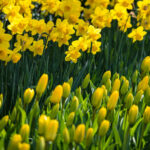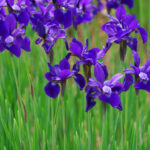Daffodil Flowers scientifically known as Narcissus, are among the most popular and widely recognized spring-blooming flowers in the world, These cheerful and vibrant blooms are synonymous with the arrival of spring, bringing with them a sense of renewal and hope after the long, cold winter months. Daffodils are beloved for their bright yellow, white, and orange hues, their trumpet-shaped flowers, and their relatively easy care requirements. They are a favorite in gardens, parks, and homes around the globe.
In this article, we will explore the fascinating characteristics of daffodil flowers, their symbolism and cultural significance, their different varieties, how to plant and care for them, and their role in gardens and landscapes
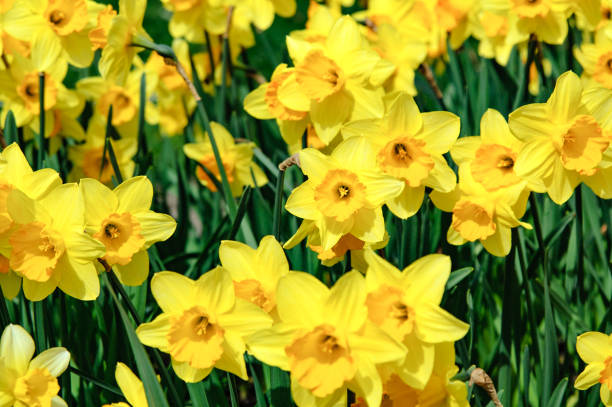
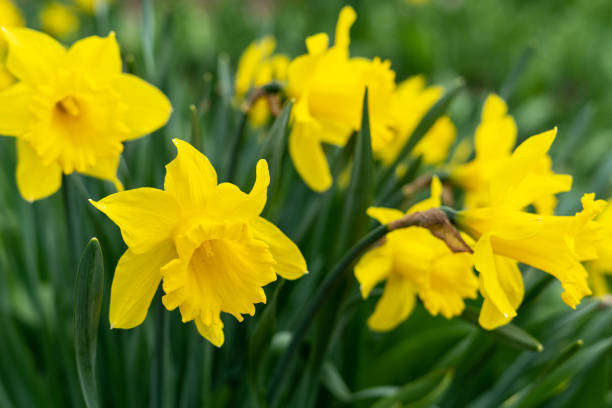
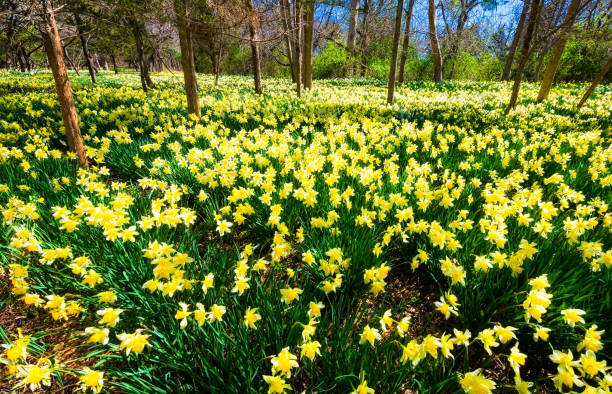
1. Overview of Daffodil Flowers
Daffodils are members of the Amaryllidaceae family, and the genus Narcissus includes around 50 species and thousands of hybrids and cultivars. They are native to regions in Europe, particularly the Mediterranean, and have been cultivated for centuries. Daffodils typically bloom in early spring, their bright colors heralding the end of winter and the beginning of warmer days.
The most recognizable feature of a daffodil is its distinct flower shape, which consists of a central trumpet or “corona” surrounded by six petal-like structures called “tepals.” While the classic daffodil is bright yellow, daffodils can also be found in shades of white, cream, orange, and even pink. The flowers can be single or double, and some varieties are fragrant, adding to their appeal.
Daffodils are hardy perennial bulbs, meaning they return year after year, often multiplying and spreading over time. Their resilience and beauty make them a staple in gardens and landscapes worldwide.
2. Symbolism and Cultural Significance of Daffodils
Daffodils have deep-rooted symbolism across many cultures, often representing themes of rebirth, hope, and new beginnings. Their appearance in early spring, sometimes even pushing through the last snow, makes them a powerful symbol of resilience and the cyclical nature of life.
a. A Symbol of Rebirth and Renewal
Daffodils are often associated with renewal and rebirth, largely due to their early bloom in spring. After months of dormancy during the cold winter, daffodils emerge from the ground and bloom in a burst of color, symbolizing new life and the start of a new growing season. This connection to renewal has made the daffodil a popular flower for spring celebrations, Easter, and other holidays that celebrate new beginnings.
b. Symbolism in Different Cultures
In various cultures, daffodils carry different meanings, often centered around good fortune and happiness. In China, for example, daffodils are associated with good luck and prosperity, especially when they bloom during the Chinese New Year. It is believed that if daffodils bloom exactly on the New Year, they bring extra wealth and prosperity for the coming year.
In the West, daffodils are linked to hope and charity. The flower is used as a symbol for several cancer charities, including the American Cancer Society’s Daffodil Days, where daffodils are sold to raise money for cancer research. The flower’s resilience and ability to bloom after harsh conditions make it a fitting emblem of hope and perseverance in the face of adversity.
c. Greek Mythology and the Story of Narcissus
The scientific name for daffodils, Narcissus, comes from Greek mythology. According to legend, Narcissus was a beautiful youth who fell in love with his reflection in a pool of water. He became so enamored with his image that he was unable to leave, eventually wasting away and turning into the flower we now know as the daffodil. This myth has given the flower additional associations with vanity and self-love, though today it is more commonly connected to positive themes of renewal and optimism.
3. Types and Varieties of Daffodils
There are numerous types of daffodils, ranging in size, shape, and color. While most people envision the classic yellow daffodil, there is a wide array of varieties that can add diversity and interest to any garden. Daffodils are generally classified into 13 divisions based on their flower forms.
a. Trumpet Daffodils (Division 1)
These daffodils are the most iconic, with a large trumpet-like corona that is longer than or equal to the length of the petals. They usually bloom in early spring and are available in various shades of yellow, white, and bicolor combinations. The popular variety ‘King Alfred’ is an example of a classic trumpet daffodil.
b. Large-Cupped Daffodils (Division 2)
Large-cupped daffodils have a corona (cup) that is shorter than a trumpet but still prominent. These daffodils come in a wide range of colors and often have contrasting cups and petals. They bloom slightly later than trumpet varieties and are known for their large, showy flowers.
c. Small-Cupped Daffodils (Division 3)
These daffodils have a smaller corona that is less than one-third the length of the petals. While their cups are more modest in size, they are still highly attractive and come in various colors. Small-cupped daffodils often have delicate, intricate designs on their cups.
d. Double Daffodils (Division 4)
Double daffodils feature multiple layers of petals or double coronas, giving them a lush, full appearance. These daffodils can resemble peonies or roses, and they come in many different colors and bicolor combinations. They add a dramatic touch to gardens and floral arrangements.
e. Tazetta Daffodils (Division 8)
Tazetta daffodils produce clusters of small flowers on a single stem. These daffodils are often very fragrant and bloom in mid to late spring. They are also known for being more tolerant of warmer climates, making them a popular choice in regions with milder winters.
f. Miniature Daffodils (Various Divisions)
Miniature daffodils are perfect for small gardens, containers, or rock gardens. These daffodils produce smaller flowers on shorter stems, but they still pack a visual punch with their vibrant colors and delicate forms. Varieties like ‘Tête-à-Tête’ are popular miniatures that bloom early in the season.
4. Planting and Caring for Daffodils
Daffodils are relatively easy to grow and care for, making them a favorite for beginner and experienced gardeners alike. With the right conditions and minimal maintenance, daffodils will reward gardeners with cheerful blooms year after year.
a. When and Where to Plant Daffodils
Daffodil bulbs are typically planted in the fall before the ground freezes. This allows them to establish roots before the winter and bloom in early spring. The best time to plant daffodil bulbs is usually between September and November, depending on your climate.
Daffodils prefer well-drained soil and should be planted in areas that receive full sun or partial shade. They can be planted in garden beds, borders, or even containers. When planting daffodil bulbs, it is important to ensure that they are placed at the correct depth—usually about 6 inches deep and 4 to 6 inches apart. The pointed end of the bulb should face upwards.
b. Watering and Fertilizing
Daffodils do not require frequent watering, especially once they are established. In fact, overwatering can lead to bulb rot. They should be watered lightly after planting, and during dry spells in spring, a moderate amount of water can help support healthy growth.
Daffodils can benefit from a balanced, slow-release fertilizer applied in the fall when they are first planted. Additional feeding in the early spring can encourage vigorous blooming. However, daffodils are generally not heavy feeders and can thrive in a wide range of soil conditions.
c. Post-Bloom Care
Once daffodils have finished blooming, it is essential to allow the foliage to die back naturally. The leaves help the bulbs store energy for the next growing season, so they should not be cut back until they have turned yellow. This process usually takes about six weeks after the flowers have faded.
Daffodils can be left in the ground year-round, and over time, they will often multiply and form larger clumps. Every few years, daffodils may benefit from being divided and replanted to prevent overcrowding and encourage better blooming.
5. Daffodils in Gardens and Landscaping
Daffodils are versatile and adaptable flowers, making them suitable for a wide range of garden settings and landscape designs. Their bright colors and early bloom time make them a popular choice for creating eye-catching spring displays.
a. Companion Planting with Daffodils
Daffodils pair well with a variety of other spring-blooming bulbs, such as tulips, crocuses, and hyacinths. They can be planted in mixed beds or borders to create a tapestry of color that brightens up the garden in early spring. Daffodils also work well in naturalized areas, such as meadows or woodland gardens, where they can spread and create a more relaxed, informal look.
b. Using Daffodils in Containers and Pots
Daffodils can be grown in containers and pots, making them an excellent choice for patios, balconies, and small spaces. When planting daffodils in containers, it is important to use well-drained potting soil and ensure that the pots have adequate drainage. Container-grown daffodils can be moved indoors during late winter to force early blooms, bringing a touch of spring into the home.
Conclusion
Daffodil flowers are a beloved and timeless symbol of spring, hope, and renewal. With their bright, cheerful blooms and relatively easy care, daffodils bring joy to gardens and landscapes around the world. Whether planted in formal beds, naturalized areas, or containers, daffodils can transform any space with their vibrant colors and charming forms. Their deep cultural significance, coupled with their beauty and resilience, ensures that daffodils will continue to be cherished for generations to come.





